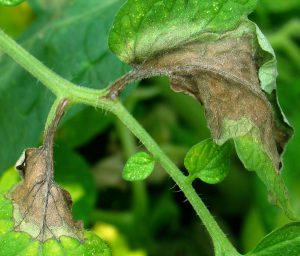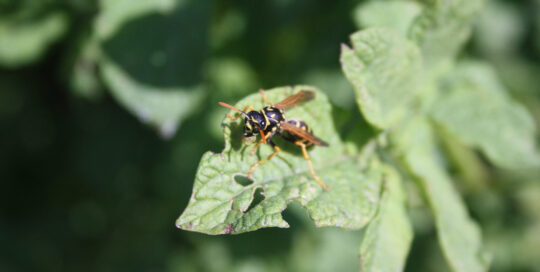The Threat of Late Blight on Tomatoes
Views: 3092

Most of the time on this blog I write about things that eat your crops, but with this spring’s warm, wet weather in many parts of the country, I wanted to give everyone a heads up about late blight.
According to the USDA, late blight is caused by Phytophthora infestans, an organism that superficially resembles a fungus, but is more closely related to the algae.”While that doesn’t necessarily help you paint a picture of what you’re dealing with, keep in mind it’s spread by spores that thrive in the recent weather conditions.
Preventing Late Blight on Tomatoes
Late blight is the same disease that caused the Great Potato Famine in the 1800s. It affects both potatoes and tomatoes, and it turns out some petunias. While I’m sure people would be disappointed if they lost spuds, there is much wailing and gnashing of teeth if tomatoes are killed. So what can you do?
Look for Tomatoes That Are Resistant to Late Blight
Since there’s still time to plant in many parts of the country, look for tomatoes that are resistant to late blight. This is the beauty of the hybrids such as Juliet, Legend, Mountain Magic, and Plum Regal.
These are perpetuated partly due to their resistance to the disease. Keep in mind, this doesn’t guarantee safety, but it helps. It’s another reason people are grafting tomatoes onto disease resistant hybrid rootstock (such as ‘Maxifort’). Heirlooms will quickly succumb to many pathogens, but by grafting them onto resistant rootstock, it allows you to enjoy the excellent varieties combined with the positive traits of the hybrid.
So, if you’re in the Northeast part of the United States, if you can grab a few late blight resistant plants, you might want to do so.
Use Certified Seed Stock for Potatoes
The other piece of the puzzle when it comes to late blight is using certified seed stock for potatoes. We’re used to it in Montana because potatoes are big business around here.
We grow much of the seed that farmers plant in Idaho. All the seed we use needs to be certified that it’s blight free, or a simple garden patch can expand into a devastating economic blow for the state. This holds true in other parts of the country. Be careful with your potato seed because if it has the spores on it, it can infect everyone else around you.
How to Identify Late Blight
Spotting late blight can be tricky because it looks like other diseases or stressed plants. Look for brownish lesions on the leaves and stems. If it’s humid, a lot of times the undersides of the leaves will be fuzzy. These are spores. It’ll continue spreading to the entire plant. When we were back in Ohio in the fall of 2009, I couldn’t believe how many dead tomato plants we saw with lots of fruit still hanging on the plant. It was sad.
Check your plants daily, weekly at the very least. I know this is a lot of work for those crazy people (like me) who have 32 plants for some inexplicable reason, but late blight develops quickly. If you see any signs of it, remove that part of the plant and put it in a plastic bag to prevent the spores from dispersing. Take it into your Extension office to confirm whether it’s late blight. If it is or more develops, destroy the plant completely. Bag up the whole thing, seal it up and throw it in the trash. You never want to compost the plant, and I’d even be leery of burning it.
What To Do
If you do have late blight, let your neighbors know so they can take measures and watch for it. If your neighbors have late blight, but you haven’t seen signs of it yet, you can use a copper fungicide, or something like “Regalia Fungicide.” You have to keep an eye on the situation until harvest, and must give them regular and thorough applications of it for it to be effective. At the end of the year, particularly if you live in the parts of the country where late blight is a problem, you might want to simply toss all of your potato and tomato foliage instead of composting it just to minimize the possibility of additional spores going into the soil to wait for ideal conditions once again. You can keep tabs on what’s happening throughout the country on http://usablight.org.
Dr. Meg McGrath, professor of plant pathology at Cornell University, graciously allowed me to use the image, which is a great representation of what you need to look for on your plants.
Meet Amy Grisak
Amy is a freelance author and photographer in Great Falls, MT who specializes in gardening, foods, and sustainable agriculture. She provides information on every kind…
Amy's Recent Posts

Looking into the Crystal Ball for a Pest Report








